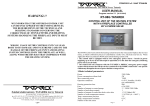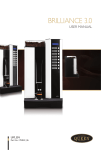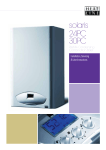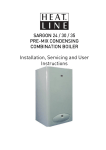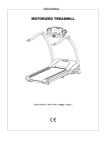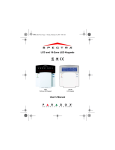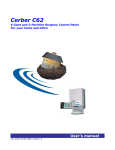Download The most user friendly Security Alarm System LS 4 0 0
Transcript
The most user friendly Security Alarm System LS400 Contents Section 1 – Overview of System 1.1 Kit Contents 1.2 Tools Required 1.3 System Features Section 2 – Planning your Installation 2.1 Location of components 2.2 Planning the location for the system components Section 3 – Installing the System 3.1 Control Unit 3.2 Movement Detector/PIR 3.3 Door/Window Contact Detector 3.4 External Siren 3.5 Testing the System Section 4 – Using the System 4.1 User PIN and Duress PIN 4.2 Changing the User PIN & Duress PIN 4.3 Set / Clear chime Zones 4.4 Set / Clear Home-Bypass Zones 4.5 Set / Clear bypass Zones 4.6 Display bypass Zones 4.7 Display Zones with faulty devices 4.8 Display Home-Bypass Zones 4.9 Set delay time 4.10 Set siren duration time 4.11 Walk Test command 4.12 Clear the Alarm Hold Indications 4.13 Panic alarm 4.14 Silencing the System 4.15 Arm (set) the Alarm System while Exiting the House 4.16 Disarm (unset) the Alarm System while Entering the House 4.17 Arm (set) the Alarm System when you are Inside the House 4.18 Summary of the zones in different mode 4.19 Summary of Factory Settings 4.20 Status LED indications Section 5 – Maintenance Section 6 – Extending the System Section 7 – Troubleshooting Section 8 – Specifications SECTION 1 – OVERVIEW OF SYSTEM The LS400 is an indoor alarm system based on our patent technology to give exceptional levels of protection and reliability. It is a fuseless system with special electronic circuitry for short-circuit protection. It is simple to use, easy to install, no special tools or training is required. IMPORTANT – Please read this manual carefully, in full, before commencing Installation. You will find installation easier if you follow these steps in the sequence shown. 1.1 Kit Contents The system comprises of: ★ CONTROL UNIT This main unit receives signals from detectors, accepts input from users and activates warning devices. ★ MOVEMENT DETECTOR PASSIVE INFRA-RED (PIR) (Two units) It senses body heat of moving person; one unit may cover entire room. ★ DOOR/WINDOW CONTACT (Four pairs) Uses a magnetically operated switch to sense the opening of door or window. ★ EXTERNAL SIREN Gives audible indication of an alarm condition to warn people who are away from the Control Unit. ★ ADAPTOR For mains supply to the Control Unit and the system. N.B. The adaptor supplied with this kit is CE approved. If other adaptor is used, make sure it is a CE approved type. The alarm kit also contains: - 50 meters of two-core flat wire and clips for wiring the detectors and external siren to the Control unit. N.B. This wire MUST NOT be used for mains connections. Screw/ wall plug packs. To complete your installation, you also require: Eight pieces 1.5V “AA” alkaline batteries for fitting inside Control Unit as back-up power source so as to maintain system functions in the event of main power failure. The batteries are not included in your kit, and need to be purchased separately. DOOR/WINDOW CONTACTS MOVEMENT DETECTOR PASSIVE INFRA-RED (PIR) (Four pairs) (Two units) CONTROL UNIT ADAPTOR EXTERNAL SIREN -2- 1.2 Tools Required The following tools are required for installation: ★ Large & small flat bladed screwdrivers and cross point screwdrivers ★ Hammer ★ Power drill ★ Wire cutters and wire stripper ★ Eye protection (recommended when using a power drill or hammer) 1.3 System Features ★ Simple and effective Four-zone system with the new two-wire technology. ★ All system components (sensors, sirens) are connected to the Control Unit via two-core non-polarity flat wires. Wiring and installation of the system is extremely simple and easy. ★ Control Unit has built-in keypad with status LEDs and zone indicators. Low battery and tamper attempts will be indicated by the status LEDs. ★ Push-button “HOME”, “OUT” and “OFF” three mode operation. ★ “HOME” and “OUT” modes are pre-programmed for user convenience. ★ At “OFF” mode, door chime function is available. ★ All sensors, sounders are 24 hour line-protected and fully supervised. Any attempt to interfere with the system, such as cutting the connecting wires or opening any of the PIR detectors, will trigger the alarm and be identified by flashing LEDs and zone indicator. ★ No fuse to burn. Short-circuit tamper attacks to any zone sensor will trigger the alarm and be identified by flashing LEDs and zone indicator, but the operation of the rest of the system is protected. ★ User PIN for disarming (unsetting) the system, plus Duress PIN to also dial out a telephone dialer (if one is fitted) when entering the premises under duress. ★ Individual zones can be set to “HOME-BYPASS” or “BYPASS”; for example, the up-stairs detectors can be set to “HOME-BYPASS” at night. ★ Two PIR motion detectors can be connected to one zone, therefore the system can be expanded to have four PIRs plus many magnetic contacts. Also, easy connections are provided for adding telephone dialer to the system. SECTION 2 – PLANNING YOUR INSTALLATION 2.1 Location of components Control Unit – Location In choosing a suitable location you should bear in mind: ★ The user needs to reach the Control Unit easily within the allocated time, when entering and leaving the premises. ★ The Control Unit should not be visible from the exterior of the protected premises. ★ All detectors and the external siren must be wired to the Control Unit. ★ The Control Unit needs to be connected to an AC main via a CE approved adapter. Having chosen the location do not mount at this stage. Movement/Passive Infra Red Detector (PIR) – Location ★ The detector should not be mounted near to large metal objects or on metal surfaces. It needs to be mounted on a wall or in a corner at a height of approximately 2 to 2.5meters for the best general coverage in an average room. The detector has been designed to avoid false alarms, nevertheless, it is best to avoid looking directly at sources of heat such as fires and boilers, and always try to keep away from a window. A PIR can look at a radiator but should not be sited above one. -3- ★ Do not site a PIR where its field of view may be obstructed (e.g. by curtains). Also note that PIRs work best when sensing movement across rather than along their detection beams. You need to consider the need to wire these units back to the Control Unit. Detection Area of PIR Having chosen the location do not mount at this stage. Door/Window Contact Detectors – Location ★ Door/ Window Contact Detector is designed to detect a door or window opening, so it is better mounted onto the frame with a magnet mounted next to it on the door or window. ★ In most applications one door contact is fitted to the front door and assigned to ZONE 1 which is the Entry/Exit Zone. When the system is set at “OUT” mode, Zone 1 allows a 30 second (adjustable) delay for the user to enter or leave the house, and should be the only zone activated before reaching the Control Unit on entering the premises. The other contact detector can be mounted to the back door or window and assigned to Zone 2. Having chosen the location do not mount at this stage. External Siren – Location ★ Choose a location for the siren box, preferably in a prominent position high up on an external wall, taking into account that it must be wired back to the Control Unit. The cable should ideally run directly from behind the siren box through the wall to the inside. This is to avoid any cable running along the exterior wall which could be reached by an intruder. Having chosen the location do not mount at this stage. -4- 2.2 Planning the location for the system components Example of a domestic layout The 2 sample layouts below are intended as guides only but demonstrate two examples of how a house can be protected with the system. Sample 1: Zone Area 1 2 3 4 Front Door Back Door Downstairs Upstairs DOOR/ WI NDOW CONTACT DETECTOR ( ZONE1) R PI DI NI NG ROOM ZONE4 LS400 CONTROL UNI T BEDROOM #1 KI TCHEN ZONE3 R PI LI VI NG ROOM BEDROOM #2 DOOR/ WI NDOW CONTACT DETECTOR ( ZONE2) BEDROOM #3 EXT. SI REN Ground Floor 2nd Floor The PIRs have been placed one downstairs and the other upstairs to protect both areas. The Door/Window Contact Detectors have been positioned to protect the front door and back door. Sample 2: Zone Area 1 2 3 4 Front Door Back Door Living Room Bedroom DOOR / WINDOW CONTACT DETECTOR (ZONE 1) ENTRANCE HALL ZONE 3 LS400 CONTROL UNIT DOOR / WINDOW CONTACT DETECTOR (ZONE 2) The Zone 3 PIR has been placed in the Dining/Living room to protect this general area. The Zone 4 PIR has been placed in Bedroom #1 (Master Bedroom) to protect the personal valuables there. Zone 4 is set as “Home-Bypass zone” so that the zone 4 PIR is disabled when the system is set at “HOME” mode. The Door/Window Contact Detectors have been positioned to protect the front door and back door. -5- SECTION 3 – INSTALLING THE SYSTEM 3.1 Control Unit ★ Remove and retain the two holding screws from front cover of Control Unit and carefully hinge off the front cover. ★ Disconnect the battery snap connecting the battery holder. Take out the battery holder. (Illustration 1) Illustration 1 ★ Place the Control Unit Mounting Template Sheet on the wall at the chosen location. Mark and drill holes for the three mounting screws. Put in the wall plugs and have the two mounting screws at the top (the hanging screws) inserted, leaving the two screws to protrude by about 5mm. ★ Aligning the Control Unit with the mounting guidelines on the template sheet and hang the Control Unit onto the two hanging screws. (Illustration 2) N.B. Do not put in the third mounting screw (the final fixing screw at the lower part of the Control Unit) until after all the wirings to the Control Unit have been done, because you may need to take the Control Unit off the hanging screws to facilitate the wiring. -6- ★ Have all the sensors (Magnetic Contacts, PIRs) and accessories (External siren, dialer, if fitted) wired up (as per Section 3.2, 3.3 and 3.4 that follows) and connected to the corresponding terminals in the Control Unit (Illustration 3). Also wire up the Main Power Adaptor to the Control Unit, but DO NOT plug in the adaptor to the main supply until all connections are completed and all units properly mounted and front cover of Control Unit closed and secured. WARNING: All connection to the mains should be made in accordance with all relevant wiring regulations. The Control Unit must never be operated from the mains with the front cover removed. Illustration 3: Part Identification (wiring reference) * All connections are simply by 2 non-polarity flat wires only. Zone Indicators Magnetic Contact in Zone 1 ( NOTE 1 ) Power Indicator Magnetic Contact in Zone 2 2-Wire PIR in Zone 3 ( NOTE 2 ) 2-Wire PIR in Zone 4 External Siren Status LEDs Enlarged View of the Terminals Adaptor NOTE 1: For connecting two pieces Magnetic Contacts to any of Zone 1 or Zone 2, see Illustration 10 on page 10. NOTE 2: The Illustration shows one piece of 2-wire PIR detector is connected to each of Zone 3 and Zone 4; and therefore the PIR zone slide switches opposite the two PIR zone (Zone 3 and Zone 4) terminals are put in position 1. For connecting two pieces PIR to the same zone, you need to put the corresponding slide switch to position 2. See Illustration 7 on page 9 for wiring. -7- ★ After all the wirings are done, put in the final fixing screw (at the lower part of the Control Unit) to secure the mounting. ★ Plug in 8 pieces AA alkaline battery into the battery holder and put it back into the Control Unit connecting it with the battery snap. ★ Put back the front cover carefully and secure it with the two holding screws, complete with the screw covers (plugs). Tear off the mounting template sheet. 3.2 Movement Detector/PIR ★ Remove and retain the screw from the bottom of the PIR and lift off the cover. ★ Carefully remove the electronic module from its retaining clips, ensuring not to touch the pyroelectric sensor (Illustration 4). Illustration 4 Illustration 5 ★ Use mounting points “A”, if you are fitting the detector in a corner. Use mounting points “B”, if you are fitting the detector on a flat surface. Use a small drill to create two fixing holes at the mounting points (Illustration 5). ★ Hold the base of the PIR in the chosen position, ensuring that the front of the PIR will face towards the center of the protected area, mark and drill two fixing holes in the wall. Choose one of the cable entry holes “C” and make a third hole in the detector base. Put one end of the 2-core wire through this hole “C”, then secure the PIR to the wall using two screws and wall plugs provided. ★ Replace the electronic module into the retaining clips, ensuring that it is correctly positioned and firmly seated. ★ If required, select the PIR LED “ON” or “OFF” option and the sensitivity (pulse count) by setting the corresponding jumpers on the electronic module. Note that Pulse 1 option is more sensitive than the pulse 4 option. Pulse 1 option is used when it is necessary to activate an alarm on the first detected pulse, or in high security installations – where fast “catch” performance is of greatest importance. Pulse 2 or 4 setting provides improved protection against false alarms caused by all types of environmental disturbances. (Illustration 6) Pulse Count Connect the two Pulse 1 wires to these two switch terminals Pulse 2 Pulse 4 Illustration 6 -8- ★ Connect the 2 wires to the PIR, polarity is not important. ★ Run the cable back to the Control Unit, fixing the cable with cable clips and enter the wire into the back of the Control Unit through any convenient cable hole. ★ Connect to zone 3 or zone 4 terminals in the Control Unit as required, connection polarity is not important. See Illustration 3 on page 7. ★ In the Control Unit, against each of the two PIR connection terminals (zone 3 and zone 4), there is a 3-position (0,1,2) slide switch. These switches are factory pre-set at position “0” when no PIR is connected. When connecting one piece 2-wire PIR to the zone, you need to set the corresponding switch to position “1”. When connecting 2 pieces 2-wire PIR to the same zone terminals, put the corresponding switch to position “2”. The wiring to connect two pieces 2-wire PIR to one same zone terminals are as Illustration 7. When the two PIRs are running in the same direction: (Switch at Position 2) When the two PIRs are running in opposite directions: (Switch at Position 2) (Switch at Position 2) Illustration 7 ★ Replace cover on PIR and refit the retaining screw. 3.3 Door/Window Contact Detector ★ Choose the location for each magnetic contact (remembering the need to wire them back to the Control Unit). Each contact consists of a magnetically-operated switch (with screw terminals at the back) and a magnet in an identical housing. ★ The switch (the part with screw terminals and cable) should be mounted on the frame. The magnet should be mounted on the door or window itself directly opposite the switch, no more than 8mm apart when the door or window is closed (Illustration 8). Mark two mounting holes for the magnet on the door or window and two mounting holes for the switch on the frame. WINDOW Illustration 8 -9- FRAME ★ Choose a convenient entry point for the cable on the switch housing and carefully remove part of the plastic using a sharp knife to create a hole (Illustration 9). Connect the 2 wires to the two screw terminals. Illustration 9 ★ Fixed the contact and magnet in position using the four mounting screws provided. ★ Run the cable back to the Control Unit. ★ Connect to zone 1 or zone 2 terminals of the Control Unit as required. Connection polarity is not important. See Illustration 3 on page 7. ★ If two magnetic contacts need to be wired to one same zone (zone 1 or zone 2), wire them up in serial connection as Illustration 10. MC 1 MC 2 Illustration 10 3.4 External Siren ★ Remove the cover retaining screw from the base of the siren cover (Illustration 11). Take off the cover from the siren baseplate. Fixing holes Illustration 11 Illustration 12 ★ Use the siren baseplate as a template to mark and drill three fixing holes (Illustration 12) in the wall at the chosen position. For mounting the siren outside the house, drill a further hole through the wall directly behind the siren for the 2 core cable to run through from the Control Unit to the Siren. ★ Mount and fix the siren with the screws and wall plugs provided. ★ Connect the 2-wire cable to the terminals inside the siren, and the other end of the cable to the corresponding terminals in the Control Unit. See Illustration 3 on page 7. ★ Replace cover on siren and refit retaining screw. - 10 - 3.5 Testing the System ★ After installation is completed, plug in the main power supply adaptor. The “POWER” indicator will illuminate and the “OFF” mode LED (green) will also light up, showing the system is in “OFF” mode. Wait about two minutes for the system to get ready. Testing the detectors With the system in “OFF” mode (“OFF” mode LED illuminated), press “*”, “6”, “1”, “#”. Two short beeps acknowledge acceptance of command and walk test mode activated. Trigger all the detectors (magnetic contacts and PIRs) one by one. The corresponding zone indicators on the Control Unit should light up. If the zone indicator does not light up, check the corresponding detector. Fix the problem and test again. Exit walk test mode by pressing “*”, “6”, “#”. Two short beeps with zone indicators turned off indicate walk test mode exited. Repeat the test periodically where necessary. Testing the external siren Use the Panic Alarm command (pressing “*” and “#” simultaneously) to trigger the alarm for testing. The built-in siren in the Control Unit will sound immediately with all four zone indicators illuminated and the external siren will sound 30 seconds later. The alarm sound will stop automatically after 3 minutes (alarm duration timer, adjustable). To stop the alarm sound, enter User PIN at the Control Unit. To clear the zone indicators, enter “*”, “8”, “#”. SECTION 4 – USING THE SYSTEM ★ Note: If you enter an invalid command or the command is incomplete, the Control Unit will give a long, low-pitched beep (“error” tone). For valid commands, the Control Unit will acknowledge acceptance with two short beeps, and if the command is related to one of the four detection zones, the corresponding zone indicator will also flash once for confirmation. 4.1 User PIN & Duress PIN ★ User PIN can disarm the system and change to OFF mode. ★ Duress PIN can disarm the system and change to OFF mode, and also trigger the telephone dialler to dial out if one is fitted. Note: The factory setting for the User PIN is 1234 and the Duress PIN is 7890. 4.2 Changing the User PIN & Duress PIN ★ User is highly recommended to change the PIN number when using it for the first time. The User PIN is set to 1234 and the Duress PIN is set to 7890 at the factory and you may change them to any four-digit numbers of your choice. The User PIN and Duress PIN will be changed back to their respective default values “1234” and “7890” if the power of the Control Unit has been reset. With the system in “OFF” mode, Change user PIN as follows: * 0 1 2 3 4 5 Default 6 7 8 # New PIN NO. Two short beeps indicate the command is successful and a long beep indicates the command is rejected. Change Duress PIN as follows: * 9 7 8 9 0 Default 6 7 8 9 # New PIN NO. Two short beeps indicate the command is successful and a long beep indicates the command is rejected. Note: The User PIN is 1234 at factory setting. The Duress PIN is 7890 at factory setting. - 11 - 4.3 Set / Clear chime Zones ★ The system can be set so that, when in “OFF” (Unset) mode, if a zone is triggered, the Control Unit with give a chime tone. This can be done for any of the four zones. With the system in “OFF” mode, Set chime flag for any Zone as follows: Zone No. (1~4) 1 * # Two short beeps and the corresponding zone indicator flashes once to confirm. Clear chime Zones as follows: 1 * # Two short beeps for confirmation. Note: The chime Zone is Zone 1 at factory setting. 4.4 Set / Clear Home-Bypass Zones ★ When the zone is set to Home-Bypass zone, the corresponding detector will not be activated in HOME mode. However, when the system is put in “OUT” mode, the Home-Bypass zone detector will be operative and, when triggered, will signal the Control Uint to alarm after 30 seconds (adjustable) delay time. . With the system in “OFF” mode, Set Home-Bypass Zone for any of Zone 2 to 4 as follows: 2 * Zone No. (2~4) # Two short beeps and the corresponding zone indicator flashes once to confirm. Clear Home-Bypass Zones as follows: 2 * # Two short beeps for confirmation. Note: Zone 4 is set as Home-Bypass Zone at factory setting. 4.5 Set / Clear Bypass Zones ★ When a zone is set to Bypass Zone, the corresponding detector will not be activated in ANY mode. With the system in “OFF” mode, Set Bypass Zone for any of Zone 2 to 4 as follows: Zone No. (2~4) 3 * # Two short beeps and the corresponding zone indicator flashes once to confirm. Clear Bypass Zones as follows: * 3 # Two short beeps for confirmation. - 12 - 4.6 Display Bypass Zones With the system in “OFF” mode, Check which zones have been set as Bypass Zones as follows: * 4 1 # Two short beeps and the zone indicators for the Bypass Zones will illuminate for a few seconds. 4.7 Display Zones with faulty devices With the system in “OFF” mode, Check which, if any, zone detector in the system has any problem as follows: * 4 2 # Two short beeps and the Zone indicator for any zone with faulty devices will illuminate for a few seconds. 4.8 Display Home-Bypass Zones With the system in “OFF” mode, Check which zones have been set as Home-Bypass Zones as follows: * 4 3 # Two short beeps and the zone indicators for the Home-Bypass Zones will illuminate for a few seconds. . 4.9 Set delay time ★ When the system is put in “OUT” mode, there is a 30 seconds (factory preset, can be changed by user to 15 or 45 seconds) delay time before the alarm will be activated. The delay time is to give the user enough time to exit or enter the premises before the alarm is activated. User may select the delay timer as follows: With the system in “OFF” mode, Set entrance / exit delay timer: * 5 1 N # N =1 for 15 sec N =2 for 30 sec N =3 for 45 sec Two short beeps indicate the command is successful and a long beep indicates the command is rejected. 4.10 Set siren duration ★ The siren is preset at the factory to a duration of 3 minutes. The alarm will stop by itself after this preset siren duration and the alarm hold indication (illuminated zone indicator) will be on. To change the siren duration, do as follows: With the system in “OFF” mode, Set siren duration timer: * 5 2 N # N =1 for 1 min N =2 for 3 min N =3 for 10 min Two short beeps indicate the command is successful and a long beep indicates the command is rejected. - 13 - 4.11 Walk Test command With the system in “OFF” mode, Enable walk test mode as follows: 1 6 * # Two short beeps confirm command is accepted and Walk Test mode is activated. Trigger all the zones and the corresponding zone indicators will illuminate. Exit walk test mode as follows: * 6 # Two short beeps and zone indicators will turn off, Walk Test mode is exited. 4.12 Clear the Alarm Hold Indications ★ To clear the alarm hold indications (illuminated zone indicators), do as follows: With the system in “OFF” mode, Key in the following buttons: * 8 # Two short beeps and all zone indicators turn off. 4.13 Panic alarm ★ Should you need to attract attention, the full alarm signal can be activated at emergency by pressing * and # together. Press * & # simultaneously, the system will sound immediately and all four zone indicators will illuminate. The external sounder and the telephone dialer (if one is fitted) will be triggered 30 seconds later. 4.14 Silencing the System ★ When the alarm is triggered, the user has to enter the PIN at the Control Unit to cancel the alarm sound. If a telephone dialer is fitted and also triggered, it will dial out automatically as preset and cannot be cancelled. ★ If the alarm has not been cancelled, the alarm sound will stop by itself after the preset alarm duration timing (3 minutes at the factory setting, adjustable by user) and the alarm hold indication (zone indicator) of the intruded zone will illuminate. 4.15 Arm (set) the Alarm System while Exiting the House Press “OUT” key for a while. The “Zone 1” indicator will illuminate while the entry zone (zone 1) is opened. The count down warning sound (exit delay) will start when the entrance door is closed. Close the door and leave the house within the exit delay time (30 seconds at factory setting, user adjustable). Both PIRs & Magnetic Switches are activated for protection after the exit time expires. Note: The system cannot enter OUT mode if zone 2 and/or 4 is triggered (Zone 2 and 4 indicators illuminated). 4.16 Disarm (unset) the Alarm System while Entering the House When you open the entrance door of zone 1, the count down warning sound (entry delay time) will be on. Enter your four-digit User PIN within the delay time (30 seconds at factory setting, user adjustable). System changes to “OFF” mode (OFF mode status LED illuminated). - 14 - 4.17 Arm (set) the Alarm System when you are Inside the House Press “HOME” key for a while. Both Magnetic Switches and PIRs are activated to protect your home except the Home-Bypass zone. You may set Home-Bypass zone for the areas where you will be in. Note: The system cannot enter Home mode if zone 1 or 2 are opened. 4.18 Summary of the zones in different mode Zone 1 (MS) 2 (MS) Home mode Instant Instant Out mode Delay Delay 3 (PIR) Delay Delay 4 (PIR) Delay Delay Usage Exit/Entry zone Protect door/window which are not often used Protect area close to exit/entry zone Protect area far away from exit/entry zone 4.19 Summary of Factory Settings Factory Preset Control Unit (1) User PIN (2) Duress PIN (3) Panic Alarm Command (4) Chime Zone (5) Home-Bypass Zone (6) Bypass Zone (7) Entrance/Exit Delay time (8) Siren Duration (9) PIR Slide Switch Position 1234 7890 ‘*’ and ‘#’ together Zone 1 Zone 4 Nil 30 sec. 3 minutes Position “0” Can be changed by User to Any 4 digit PIN Any 4 digit PIN Cannot be changed Any Zone Zones 2, 3 &/or 4 Zones 2, 3 &/or 4 15, 30 or 45secs 1, 3 or 10 minutes 0, 1 or 2 according to the number of PIRs connected Section 4.1 & 4.2 Section 4.1 & 4.2 Section 4.13 Section 4.3 Section 4.4 & 4.8 Section 4.5 & 4.6 Section 4.9 Section 4.10 Section 3.2 (Illustration 7) Section 3.2 (Illustration 6) Section 3.2 (Illustration 6) PIR Movement Detector (1) Test LED Jumper “ON” ON or OFF (2) Pulse Count Jumper Pulse 2 Pulse 1, 2 or 4 - 15 - Manual Reference 4.20 Status LED indications: STATUS LED “HOME” LED illuminated INDICATIONS System armed (set) with INSTANT Magnetic Contacts and DELAY PIRs, and any Home-Bypass zone will be inactive (i.e. detectors in the Home-Bypass Zone will be disabled, e.g. at night with people inside house, the PIR inside the house can be set to “Home-Bypass”) “OUT” LED illuminated System armed (set), with “Delay” for all four zones. “OFF” LED illuminated System “disarmed” (unset), ready to accept User commands. Also “Chime” function operative and Chime can be programmed for any of the four zones. “OFF” LED flashing Low back-up battery. “HOME” and “OUT” LEDs flashing together TAMPER, and Zone Indicator(s) for the tampered zone(s) also illuminated. SECTION 5 – MAINTENANCE Once every three months, ★ Test all detectors. ★ Test sirens. Additionally, once every three years, ★ Replace the Alkaline batteries in the Control Unit. SECTION 6 – EXTENDING THE SYSTEM A number of accessories are available to expand your system to suit your exact requirements. ★ Wired Movement Detector/PIR – covers a large area, easy to wire. ★ Wired Door/Window Contact Detector – small, robust and reliable. ★ Auto Voice Dialer – will phone you when your premises is alarmed. There is a simple plug-in connector at the back of the electronic circuit board of the Control Unit for easy connection to the dialer. - 16 - SECTION 7 – TROUBLESHOOTING Control Unit Possible causes & cures Power Indicator and all status LEDs do not light No power supply to unit. Check connections to up – unit totally “dead” mains and backup battery. Power Indicator does not light up and one of the Main supply off, unit operating from backup status LEDs (“HOME” or “OUT” or “OFF”) battery. illuminated. Check mains connections /adaptor. When power is applied, siren sounds and “OFF” Tamper fault on PIR detectors. Check the wiring status LED (green) illuminated, “HOME” (red) of the PIR zones (Zones 3 and 4) to Control Unit. and “OUT” (red) LEDs are flashing. Check the PIR detector cover is correctly fitted and securely fastened. “OFF” status LED (green) flashing. Low backup battery condition in Control Panel, replace batteries as soon as possible. When “OUT” key is pressed, unit will not arm, Indicated zone(s) open/triggered. give “error” tone (one long beep) and zone 2 Check that zone 2 and/or 4 are cleared and/or zone 4 indicator(s) illuminates. (door/window closed, no movement near PIR), and try again. When “HOME” key is pressed, unit will not arm, Indicated zone(s) open. give “error” tone (one long beep) and zone 1 Check that all magnetic contacts (zone 1 and zone and/or zone 2 indicator(s) illuminates. 2) are closed, and try again. PIR Detector Possible causes & cures Does not detect movement (PIR’s LED does not Is the PIR’s LED turned off? light up when triggered). PIR causes false “intruder” alarms. Check that PIR is not pointed at heat sources or moving object, and is not mounted above a radiator or other heater. PIR will not trigger alarm when the system is set PIR not yet warms up. (armed). Wait for a couple of minutes and trigger the PIR again. Magnetic Contact Detector Possible causes & cures Does not detect opening of door or window Check that magnet is correctly positioned. (corresponding zone indicator does not illuminate when door/window is opened, whilst system is armed or during walk test). External Siren Siren does not sound during test or full alarm. Possible causes & cures Check all siren wiring and connections. Remark: If you have any problem with the system of LS400, take off the battery and disconnect the mains for couple of minutes. The system will reset to factory default settings. - 17 - SECTION 8 – SPECIFICATIONS Control Unit Type Housing Zones Entry/Exit Delay Siren Duration Siren/Strobe Outputs Microprocessor based control unit with new two-wire technology ABS 4 Alarm Zones (Expandable by connecting 2 PIRs to each of Zones 3 and 4) 15, 30, 45 seconds, programmable 1, 3, 10 minutes, programmable 12V PIR Type Housing Adjustments Test LED Mounting height Detection Range Dual Pyroelectric element with hemispherical lens and new two-wire technology ABS Pulse Count (1, 2 or 4) Selectable (on/off) 2-2.5m Up to 15m Door/Window Contact Detector Type Magnetically - actuated switch Housing ABS External Siren Unit Type Housing Siren Output Piezo electronic external siren ABS 110dB min. at 1m - 18 -


















